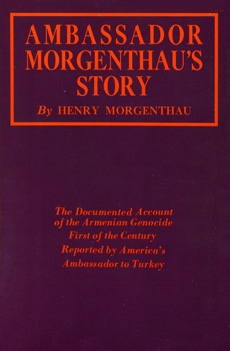| Éditeur : New Age Publishers | Date & Lieu : 1919, New York |
| Préface : | Pages : 408 |
| Traduction : | ISBN : |
| Langue : Anglais | Format : 130x195 mm |
| Code FIKP : Liv. Eng. Mor. Amb. 103 | Thème : Général |
|
Présentation
|
Table des Matières | Introduction | Identité | ||
 Ambassador Morgenthau’s Story | |||||
| Table des Matières | ||||
The Following Photographs Have Been Added to the Reprinted Edition The President speaks / i Via Dolorosa (illustration) / vi Mound of skulls in Der-el-Zor / viii Three generations of Morgenthaus / xvi Facing Page Kharput laid waste / 69 A starving child . . . Brought back to life by the Near East Relief / 94 Favorite Turkish sport / 128 Bashibozouks of .Asia Minor / 146 The destitute / 171 Human wreckage / 230 Armenian woman / 252 Armenian bread-seller / 253 Atrocities / 260 Weeding out the men / 292 The long line that leads to death / 293 Turkish hangmen and their victims / 301 Starving Armenians / 343 "Orphan City" of the Near East Relief / 384 Devouring a cadaver / 385 In the desert of Der-el-Zor / 397 Beheaded Armenian clergy / 408 List of illustrations Henry Morgenthau / Frontispiece Mrs. Henry Morgenthau with Soeur Jeanne / 8 Constantinople from the American Embassy / 9 Beylerbey palace on the Bosphorus / 16 The American Embassy at Constantinople / 16 Henry Morgenthau, American Ambassador to Turkey, 1913-1916 / 17 Talaat Pasha, ex-Grand Vizier of Turkey / 48 Turkish infantry and cavalry / 49 Bustany Effendi / 56 Mohammed V, late Sultan of Turkey / 57 Wangenheim, the German Ambassador / 68 The Sultan, Mohammed V, going to his regular Friday prayers / 72 Talaat and Enver at a military review / 73 Baron Von Wangenheim, German Ambassador to Turkey / 80 Djemal Pasha, Minister of Marine / 81 The Marquis Garroni, Italian Ambassador to the Sublime Porte in 1914 / 112 M. Tocheff, Bulgarian Minister at Constantinople / 112 The American summer Embassy on the Bosphorus / 113 Enver Pasha, Minister of War / 120 Said Halim, Ex-grand Vizier / 121 Sir Louis Mallet and M. Bompard / 136 Gen. Liman von Sanders / 137 German and Turkish officers on board the Goeben / 144 Bedri Bey, Prefect of Police at Constantinople / 145 Djavid Bey, Minister of Finance in Turkish Cabinet / 145 The British Embassy / 176 Robert College at Constantinople / 177 The American Embassy Staff / 184 The Modem Turkish soldier / 185 The Ministry of War / 200 The Ministry of Marine / 200 Halil Bey in Berlin / 201 Talaat and Kühlmann / 201 General Mertens / 201 The Red Crescent / 208 Enver Pasha / 209 Turkish quarters at the Dardanelles / 240 Looking north to the city of Gallipoli / 241 The British ship Albion / 248 The Dardanelles as it was March16, 1915 / 249 Tchemenlik and Fort Anadolu Hamidie / 264 Fort Dardanos / 265 The American ward of the Turkish hospital / 272 Students of the Constantinople College / 273 Abdul Hamid / 304 A characteristic view of the Armenian country / 305 Fishing village on Lake Van / 312 Refugees at Van crowding around a public oven, hoping to get bread / 313 Kaiser William II, in the uniform of a Turkish Field Marshal / 328 Interior of the Armenian church at Urfa / 329 Armenian soldiers / 336 Those who fell by the wayside / 337 A view of Harpoot / 337 View of Urfa / 368 A relic of the Armenian massacres at Erzingan / 368 The funeral of Baron von Wangenheim / 369 The Near East Relief Photographs facing pages 94, 171, 230, 384 are adapted from "Story of the Near East Relief" by James L. Barton, The Macmillan Co., New York, 1930. The book is an account of the great humanitarian crusade undertaken by American missionaries and laymen to rescue Armenians and Greeks from the ravages of Turkish geno-cidal policy, whose avowed aim was the total extermination of all the minorities in Turkey. | ||||